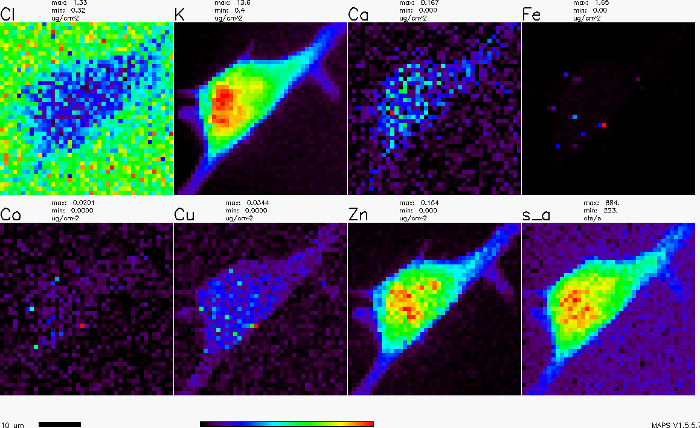Fluorescenza a raggi X (XRF)
Panoramica
Fonte: Laboratorio della Dott.ssa Lydia Finney — Argonne National Laboratory
La fluorescenza a raggi X è una radiazione indotta ed emessa che può essere utilizzata per generare informazioni spettroscopiche. La microscopia a fluorescenza a raggi X è una tecnica di imaging non distruttiva che utilizza l'emissione di fluorescenza indotta dei metalli per identificare e quantificare la loro distribuzione spaziale.
Procedura
1. Preparazione delle finestre in nitruro di silicio
- Usa una pinzetta inversa per raccogliere una finestra (le finestre in nitruro di silicio si frantumano se cadono).
- Posiziona la finestra su una diapositiva di vetro, lato piatto verso l'alto.
- Aderisci a piccoli pezzi di scotch ai lati della finestra e usali per far aderire le finestre sul fondo del piatto di cultura.
- Sterilizzare le finestre nei piatti di coltura con radiazioni UV. Ciò può essere ottenuto con l'impostazione di re
Risultati
La mappa di fluorescenza a raggi X di una cellula aderente è mostrata nella Figura 1. Ogni pannello mostra la distribuzione di un particolare elemento (ad esempio, rame, ferro, zinco, ecc.) sulla cella. Il pannello etichettato "s_a" mostra l'assorbimento dei raggi X.

Figura 1. Mappa di fluorescenza a raggi X di una cellula aderente.
Applicazione e Riepilogo
L'imaging a fluorescenza a raggi X può essere uno strumento utile in molti campi tra cui geoscienze, scienze forensi, scienza dei materiali, biologia e persino nello studio del nostro patrimonio culturale. Nella scienza dei materiali, può aiutare a trovare difetti in chip e catalizzatori realizzati con metalli. Nel lavoro sul patrimonio culturale, è stato utilizzato per identificare metalli velenosi nei capelli di famosi morti (ad esempio, Beethoven) e per identificare la fonte di vernici utilizzate nell'arte. In biol...
Tags
Vai a...
Video da questa raccolta:

Now Playing
Fluorescenza a raggi X (XRF)
Analytical Chemistry
25.4K Visualizzazioni

Preparazione del campione per la caratterizzazione analitica
Analytical Chemistry
84.8K Visualizzazioni

Standard interni
Analytical Chemistry
204.8K Visualizzazioni

Metodo delle aggiunte standard
Analytical Chemistry
320.2K Visualizzazioni

Curve di calibrazione
Analytical Chemistry
797.0K Visualizzazioni

Spettroscopia ultravioletta/visibile (UV-VIs)
Analytical Chemistry
623.7K Visualizzazioni

Spettroscopia Raman per analisi chimiche
Analytical Chemistry
51.2K Visualizzazioni

Gascromatografia con rivelatore a ionizzazione di fiamma
Analytical Chemistry
282.1K Visualizzazioni

Cromatografia liquida ad alta prestazione (HPLC)
Analytical Chemistry
384.6K Visualizzazioni

Cromatografia a scambio ionico
Analytical Chemistry
264.6K Visualizzazioni

Elettroforesi capillare
Analytical Chemistry
94.0K Visualizzazioni

Introduzione alla spettrometria di massa
Analytical Chemistry
112.3K Visualizzazioni

Microscopia elettronica a scansione (SEM)
Analytical Chemistry
87.2K Visualizzazioni

Misurazioni elettrochimiche di catalizzatori supportati mediante l'utilizzo di un potenziometro/galvanometro
Analytical Chemistry
51.4K Visualizzazioni

Voltammetria ciclica
Analytical Chemistry
125.3K Visualizzazioni